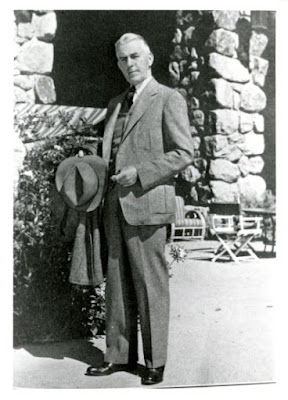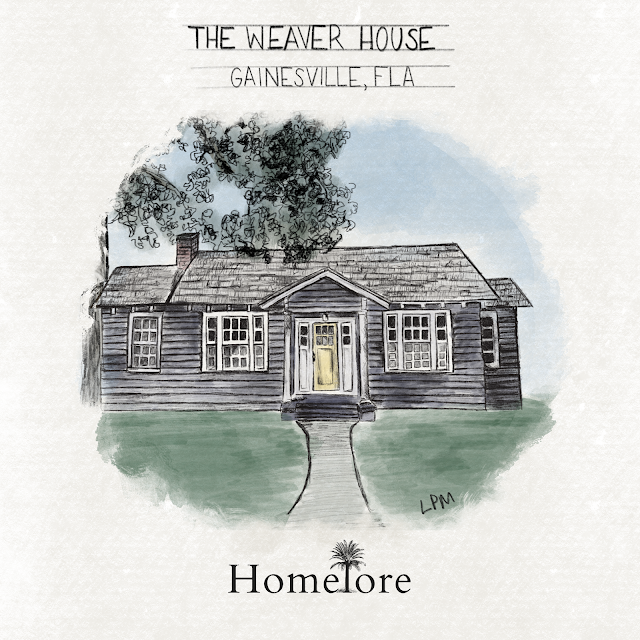A few years ago, my good friend Shannon bought a 1920s bungalow in Duckpond, a historic neighborhood in Gainesville, FL. I showed up to her previous house while she was going through items she didn't plan to bring to her "new" house and I started peppering her with questions. Who lived in that house? Do you think there's anything hidden in the walls? What are you going to name it?
She's really nice and patient with me. She said she only knew the name of the person she bought the house from and that there was evidence that it was a kit house based on instructions they found inside the walls. See? People who buy old houses love to look inside the walls.
I left her house that day with two heavy things weighing on me: knowledge that I needed to get Shannon a housewarming gift that taught her more about her lovely 1920s kit house, and an antique wardrobe that she said would fit better in my house than hers. Again, Shannon is really nice.
The Story of The Weaver House
I'm sharing just a few points from the research I found because I couldn't fit it all into a reasonable-sized blogpost. I hope you'll come back to visit for more in the future!
1920s: Marjorie and George Bailey
Before uncovering any details about previous occupants, I had to consider the actual address of the home. In Gainesville, streets are numbered according to a logical grid system, but they used to have names from Alabama Street to Yulee Street. Knowing if your home had a different address at one point is critical to finding out its history. I won't disclose Shannon's address, but it used to be called Bay Street and George and Marjorie Bailey were the first occupants.
 |
| George and Marjorie Bailey in 1922 Gainesville Directory |
George was a salesman at Baird Hardware Company, just a mile away from his home.
George and Marjorie built a quiet life in Gainesville but they quickly outgrew the kit house on Bay Street. Marjorie wanted a big family, so they followed opportunity to New Jersey, where George sold insurance instead of hardware. He passed away in 1964, leaving Marjorie and their two daughters and one son.
1920s-1960s: Alice and Rudolph Weaver
I'm not a professional (or unprofessional) historic preservationist, I'm just writing on my blog. So I don't know the rules and I apologize to the professionals if I'm bending them. Are homes named after the first occupant or the ones who were well known? Maybe this home should be called the Bailey House, but the Weavers stole my heart. They deserve several blog posts on Homelore, but I'll try to capture the most salient points here.
In 1925, the Baileys sold their kit house on Bay Street to the Weaver family.
 |
| 1930 Census showing Rudolph and Alice Weaver. Home is valued at $9,000 |
Who were the Weavers?
Rudolph Weaver was an architect.
Since I'm not a professional (as stated earlier), I can say this:
isn't he a handsome guy?? He looks like he belongs in a film noir about an architect who moonlights as a detective. That might be a great idea for another blog post. ;)
Rudolph Weaver dedicated his life to architecture. He was born in 1880 in Pennsylvania and later moved to Washington, teaching at Washington State University. That's where he met Alice. *cue dreamy music*
If you were beginning to think Rudolph was the highlight of this post, think again. Let me introduce you to Alice Walden, aka Alice Weaver.
Alice Walden/Weaver was a pianist.
She appears so serene in her photo, like she's calmed by music playing around her.
Alice was born in 1878 in Wisconsin and graduated with a degree in music from Wisconsin University. She spent her life performing and studying music around the world:
Reading about Alice's career as a pianist--from studying in Germany to teaching at Washington State University (WSU)--was making me fall in love with Alice, but I wasn't alone. In the summer of 1921, during a torrential downpour, Alice stayed late in the music department at WSU to wait for the rain to settle down. Thinking she was alone, she sat down to play a thunderous song that would dance with the rain.
Rudolph had just run inside for protection from the storm when he heard
Polonaise in C Sharp Minor by Chopin echoing through the halls. He approached the room where Alice played and watched her hair dance with her fingers, admiring her ability to compose the storm around her.
For the rest of that summer, Rudolph dedicated every day to writing poems and compositions for Alice. In the fall, they would surprise WSU faculty and staff with the passionate performance of Chopin that made Rudolph fall in love, and the summer songs written and composed by Rudolph that made Alice fall in love.
 |
| "The feature and surprise of the evening was the singing of three numbers, "Aspiration," "Prayer" and "The Everlasting Mystery," the words and music of which were written and composed by Rudolph Weaver and Miss Alice Walden. |
The next year, they married.
Alice and Rudolph move to Gainesville
In 1925, the Weavers moved to Gainesville where Rudolph Weaver would become the first director of UF's School of Architecture and Allied Arts.
During his time as the university's architect, Weaver designed several buildings in the collegiate gothic style, including multiple residence halls, the student infirmary, and Norman Hall. He also designed the
Seagle Building off-campus.
His designs were stately with details found in every nook and cranny. Weaver's designs are what I love the most about working on University of Florida's (UF) campus--I find something new every time I look at them.
Rudolph poured his energy into the designs of some of the most impressive buildings UF would ever see, then came home to his lovely and simple prefabricated kit house. There was no custom molding, towers, or Gothic cast stone tracery, but it was filled with the love and music of Alice.
Welcome home, Shannon
Neither one of us was expecting this result when I went on a search to learn about her kit house. I didn't want to just dump a bunch of pictures in front of her and say "hey Shannon, an architect used to live in your house!" She needed to know about Alice too, especially since Shannon moved her piano into the same room that Alice played hers in. I put together this timeline and wrote a short story from the house's point of view. When Alice moved to Gainesville, she stopped performing at concerts and mostly played songs for her little kit house. Now it's Shannon's turn.
Disclaimer: I may have embellished on some details...like the night of the storm when they met. Whatever happened, you know that an architect and musician falling in love is a beautiful thing.











No comments :
Post a Comment